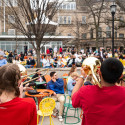The icewoman cometh: Coach anticipates hockey debut

|
|
“I am all about hockey. The more hockey going on, the better,” Julie Sasner says from the third-floor of Camp Randall Stadium where her team’s offices and conference room are located.
But she wasn’t always “all about hockey.” The 33-year-old Durham, N.H., native grew up playing hockey on the pond behind her family’s house. But she also played little league baseball (pitcher and second base). “I like to tell people I was in the Red Sox organization,” she jokes. She also played basketball, soccer, tennis, track and field hockey while at Oyster River High School. It wasn’t until college, where she majored in social anthropology at Harvard University, that Sasner got to play ice hockey on a school team. A soccer standout at Harvard as well, Sasner’s first collegiate head coaching job was directing the women’s soccer team at California State University-Hayward, where she also earned a master’s degree in college counseling. “I always knew that I’d coach. I just never knew that I’d be able to earn a living from it,” Sasner says, noting that only recently have there been good opportunities for women to make a career out of coaching. When she was offered the coaching job at Cornell in 1993, Sasner jumped at the chance to coach an ice hockey team, especially in the well-established Eastern Collegiate Athletic Conference. Having coached both hockey and soccer, she appreciates hockey’s much longer season – which means more time on ice with the players instead of shuffling papers in the office. It’s also the sport she excelled in most. A member of the first U.S. Women’s National Ice Hockey Team, she played side-by-side with Cammi Granato as they took the silver medal at the world championships in 1990. At Harvard, Sasner was rookie of the year and 1988 Ivy League Player of the Year. Moving a thousand miles west to Wisconsin seems a logical and exciting step for Sasner. She runs through the list of advantages to coaching here, such as the facilities for training and playing, and the “opportunity to work with really good coaches like Jane Albright and Jeff Sauer,” who share advice on recruiting, talking with parents, and managing a Big Ten team. “The Wisconsin Athletic Department does things in a really big way,” she says. |
Coach Julie Sasner, of the new women’s ice hockey team, hates being asked: “How does it feel to be the reason that baseball’s not here?”
But Sasner quickly adds, “I think they should ask the question.”
Sasner says the question, which she has faced several times since coming to the university, is a sign of how “invested” Wisconsin fans are in their Badger teams – from the now-defunct men’s baseball team to her new 18-scholarship-strong women’s hockey team.
The question also refers to UW–Madison’s struggle to mete out gender equity in its sports program. With a federal requirement that the same proportion of women in the university participate in intercollegiate athletics, UW–Madison, like many schools nationwide, has reduced the number of men’s teams while adding more programs for women athletes. The university launched a women’s softball program in 1995; ice hockey debuts this October.
The point, Sasner says, trying to stay out of the fray, is that opportunities should be the same for men and women students.
“They go to the same classes. They have the same academic experiences. They stay in the same dorms and eat in the same dining halls. (The women) should not be made to feel second class. They should not be made to wait for scraps. We need to find ways to do that,” she says.
But this sentiment comes from the same coach who says it’s important for the men’s and women’s hockey teams to get along because they are all together in the same sport. And, most importantly, she doesn’t want the men to feel that they are losing anything – from the number of ice packs in the locker room to the dishes left on a dinner training table – because now there are two hockey teams instead of one.
As coach and as the first person to head up UW’s women’s ice hockey program, Sasner describes her job as being all about people. After moving to Wisconsin from Cornell University last year, she has spent 12 months off the ice, assembling a full-time staff of two assistant coaches, an administrative assistant to handle travel arrangements and other tasks, and a program assistant to run the office. Their goal is to build from the ground up not just a team, but an established “program.”
“There aren’t that many programs in the country with this many full-time staff,” she notes. That means more time for her to spend on the ice with her players.
“I think the most important reason I came here is because of the time I can devote to coaching,” she says. But first she had to find the players.
Sasner’s first recruit was Jackie MacMillan, a goaltender from Buffalo, Minn. MacMillan had planned to play for Sasner at Cornell, but when Sasner took the coaching job at UW last year, MacMillan chose to follow. MacMillan was very impressed with all a Big Ten athletic program had to offer, Sasner says. And as a sophomore education major, MacMillan takes classes this fall in one of the nation’s top-ranked education programs.
Sasner says her seven scholarship recruits and the 35 women expected to try out for the team next month are pioneers with the guts to see “the dream” of the future, a dream richly aided by men’s hockey coach Jeff Sauer and other athletic department staff who have contributed to getting the women’s team off to a skating start.
Ironically, it’s baseball’s influence Sasner cites as inspiration in designing the team’s jerseys. Just as professional baseball jerseys do not list the team’s home location on home uniforms, the women’s hockey team will feature only a proud Bucky Badger on the front of their home uniforms; a “motion W” replaces Bucky on away jerseys.
“I believe in tradition and knowing your past and knowing your time and context and where you sit,” Sasner says.



